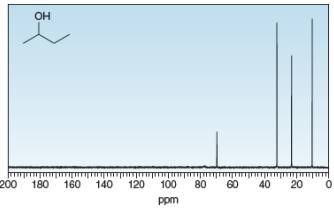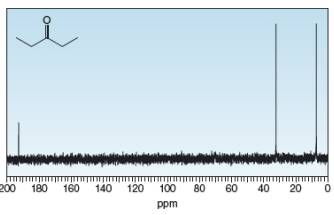
PKG ORGANIC CHEMISTRY
5th Edition
ISBN: 9781259963667
Author: SMITH
Publisher: MCG
expand_more
expand_more
format_list_bulleted
Concept explainers
Textbook Question
Chapter 14, Problem 14.31P
Identify the carbon atoms that give rise to each NMR signal.
a. 
b. 
Expert Solution & Answer
Want to see the full answer?
Check out a sample textbook solution
Students have asked these similar questions
Question 5: Name the following compound in two ways
using side chain and using prefix amine (Common name
and IUPAC name both)
CH3NH2
CH3CH2NHCH3
CH₂CH₂N(CH3)2
Draw the structure of diethyl methyl amine
Question 6. Write the balanced combustion reaction
for:
a. Hexane
b. Propyne
c. 2-pentene
Question 7: Write the following electrophilic
substitution reactions of benzene:
Hint: Use notes if you get confused
a. Halogenation reaction:
b. Nitration reaction :
c. Sulphonation reaction:
d. Alkylation reaction:
e. Aceylation reaction:
Question 4. Name the following structures
○
CH3-C-N-H
H
CH3CH2-C-N-H
H
CH3CH2-C-N-CH3
H
A. Add Water to below compound which 2-methyl 2-butene (addition Reaction)
H₂C
CH₂
CH,
+ H₂O-> ?
Major product?
Minor product?
B. Add Bromine to the compound which 2-methyl 2-butene (addition Reaction)
CH₂
CH₂
+ Br₂→ ?
Major product and Minor product both are same in this?
C. Add Hydrogen Bromide to the compound which 2-methyl 2-butene (addition
Reaction)
H,C
CH₂
CH₂
+ HBr
Major product?
Minor product?
D. Add Hydrogen to the compound which 2-methyl 2-butene (addition Reaction)
CH₂
CH₂
+ H₂
Major product and Minor product both are same in this?
Chapter 14 Solutions
PKG ORGANIC CHEMISTRY
Ch. 14 - Problem 14.1 The NMR spectrum of recorded on a ...Ch. 14 - Prob. 14.2PCh. 14 - How many NMR signals does each compound show?
a....Ch. 14 - How many 1H NMR signals does each...Ch. 14 - How many 1H NMR signals does each compound give?...Ch. 14 - Label the protons in each highlighted CH2 group as...Ch. 14 - How many 1H NMR signals would you expect for each...Ch. 14 - Prob. 14.8PCh. 14 - For each compound, first label each different type...Ch. 14 - Label each statement as True or False. a. When a...
Ch. 14 - Prob. 14.11PCh. 14 - Problem 14.12 Which compound give a NMR spectrum...Ch. 14 - Prob. 14.13PCh. 14 - Prob. 14.14PCh. 14 - For each compound give the number of 1H NMR...Ch. 14 - Prob. 14.16PCh. 14 - Prob. 14.17PCh. 14 - Problem 14.18 Describe the NMR spectrum of each...Ch. 14 - Problem 14.19 Draw a splitting diagram for in ,...Ch. 14 - Problem 14.20 Identify A and B, isomers of...Ch. 14 - Problem 14.21 How many signals are present in the ...Ch. 14 - Problem 14.22 What protons in alcohol A give rise...Ch. 14 - How many peaks are observed in the NMR signal for...Ch. 14 -
Problem 14.24 Propose a structure for a compound...Ch. 14 - Problem 14.25 Propose a structure for a compound...Ch. 14 - Problem 14.26. Identify products A and B from the...Ch. 14 - Problem 14.27 How many lines are observed in the ...Ch. 14 - Problem 14.28 Draw all constitutional isomers of...Ch. 14 - Problem 14.29 Esters of chrysanthemic acid are...Ch. 14 - Prob. 14.30PCh. 14 - Problem 14.31 Identify the carbon atoms that give...Ch. 14 - Problem 14.32 A compound of molecular formula ...Ch. 14 - Problem 14.33 Draw the structure of a compound of...Ch. 14 - 14.34 (a) How many NMR signals does each of the...Ch. 14 - 14.35 (a) How many NMR signals does each compound...Ch. 14 - Prob. 14.36PCh. 14 - 14.37 How many NMR signals does each natural...Ch. 14 - Prob. 14.38PCh. 14 - 14.39 What effect does increasing the operating...Ch. 14 - Prob. 14.40PCh. 14 - 14.41 How could you use chemical shift and...Ch. 14 - Prob. 14.42PCh. 14 - 14.43 How can you use NMR spectroscopy to...Ch. 14 - Prob. 14.44PCh. 14 - Prob. 14.45PCh. 14 - Prob. 14.46PCh. 14 - Prob. 14.47PCh. 14 - 14.48 How many NMR signals does each compound...Ch. 14 - 14.49 Rank the highlighted carbon atoms in each...Ch. 14 - 14.50 Identify the carbon atoms that give rise to...Ch. 14 - 14.51 a. How many signals does dimethyl...Ch. 14 - 14.52 Answer the following questions about each of...Ch. 14 - 14.53 Propose a structure consistent with each set...Ch. 14 - 14.54 Identify the structures of isomers A and B...Ch. 14 - 14.55 Reaction of with affords compound W,...Ch. 14 - 14.56 Treatment of with , followed by aqueous
...Ch. 14 - 14.57 Compound C has a molecular ion in its mass...Ch. 14 - 14.58 As we will learn in Chapter 20, reaction of ...Ch. 14 - 14.59 Identify the structures of isomers E and F...Ch. 14 - 14.59 Identify the structures of isomers H and I...Ch. 14 - 14.61 Propose a structure consistent with each set...Ch. 14 - 14.62 Reaction of with , followed by treatment...Ch. 14 - Reaction of aldehyde D with amino alcohol E in the...Ch. 14 - 14.64 Propose a structure consistent with each set...Ch. 14 - 14.65 In the presence of a small amount of acid, a...Ch. 14 - 14.66 Treatment of with affords two products (M...Ch. 14 - 14.67 Compound O has molecular formula and shows...Ch. 14 - 14.68 Compound P has molecular formula . Deduce...Ch. 14 - 14.69 Treatment of with strong base followed by ...Ch. 14 - 14.70 When -bromo--dimethylbutane is treated with...Ch. 14 - 14.71 Propose a structure consistent with each set...Ch. 14 - 14.72 Reaction of unknown A with forms...Ch. 14 - Prob. 14.73PCh. 14 - 14.74 -Annulene shows two signals in its ...Ch. 14 - 14.75 Explain why the spectrum of-methylbutan--ol...Ch. 14 - 14.76 Because has an odd mass number, nuclei...Ch. 14 - 14.77 Cyclohex--enone has two protons on its...
Additional Science Textbook Solutions
Find more solutions based on key concepts
1. Suppose a chloride ion and a sodium ion are separated by a center—center distance of 5 Å. Is
the interactio...
Biochemistry: Concepts and Connections (2nd Edition)
Identify each of the following reproductive barriers as prezygotic or postzygotic. a. One lilac species lives o...
Campbell Essential Biology with Physiology (5th Edition)
Separate the list P,F,V,,T,a,m,L,t, and V into intensive properties, extensive properties, and nonproperties.
Fundamentals Of Thermodynamics
Label each statement about the polynucleotide ATGGCG as true or false. The polynucleotide has six nucleotides. ...
General, Organic, and Biological Chemistry - 4th edition
The validity of a scientific law.
Physical Universe
Knowledge Booster
Learn more about
Need a deep-dive on the concept behind this application? Look no further. Learn more about this topic, chemistry and related others by exploring similar questions and additional content below.Similar questions
- 36) Complete the following multi-step reactions showing applications of enolate ions arising from ketones, esters, malonic ester, and keto ester, etc. (30 pts) (1) A NaOH, H₂O+ heat A NaOEt EtO OEt (11) EOH, H+ H. B LDA, H₂O+ -78°C B (i) NaOMe, Et-Br (ii) H₂O+, heat EtOOC (III) COOEt B A (i) NaOEt LiAlH 4-bromo-2-butene H₂O+ (ii) H3O+, heat Write the mechanism for Aldol Condensation (I A or B), and Claisen Condensation (II A).arrow_forward31) Complete two sets of reactions involving (R)-4-methyl-pent-2-ol producing racemic mixture of tertiary alcohols (D) and ketone derivative (C). Illustrate the mechanism of B and C or D. (25 pts) O OH 0 K2Cr2O7 Ph-CH2-Br, Mg, H2SO4 THF, H3O* (A) (D) Racemic mixture TsCl, Py (B) KCN, DMSO Ph-CH2-Br, Mg, THF, H3O+ (C) Mechanism for reactions B and C:arrow_forwardManoharan Mariappan, Ph.D., Dept. of Natur. Sci., NFC, Tallahassee, FL 33) Synthesize the aromatic compound containing para-substituted carbonyl compound starting from benzene. Illustrate the mechanism for reaction A. 1) NU (25 pts) A FeCl B (i) HNO3, H2SO4 (II) Sn, HCl(aq) NH₂ NO₂-D NH₂ (i) MeCO2Me, heat C (ii) K2Cr2O7/H2SO4 D (ii) SOCl2 (iii) 2 Et-NH2 Mechanism for reaction for the nitration of alkyl benzene (B-i): Characterize the product compound arising from the reaction D by IR and IH NMR spectral data: IR data (cm): 'H NMR data: Draw the structure and assign the chemical shift with the spin-splitting.arrow_forward
- Write structural formulas for the major products by doing addition reactions 1. You must add H2 as Pt is catalyst it does not take part in reactions only speed up the process H₂ CH2=CH-CH3 Pt 2. Add HCI break it into H and Cl CH3 HCI 3. Add Br2 only CC14 is catalyst CH3-CH=CH2 B12 CCl4 4. Add water to this and draw major product, H2SO4 is catalyst you have add water H20 in both the reaction below H₂SO4 CH3-CH=CH2 CH3 H2SO4/H₂O CH3-C=CH2 reflux ?arrow_forwardPlan the synthesis of the following compound using the starting material provided and any other reagents needed as long as carbon based reagents have 3 carbons or less. Either the retrosynthesis or the forward synthesis (mechanisms are not required but will be graded if provided) will be accepted if all necessary reagents and intermediates are shown (solvents and temperature requirements are not needed unless specifically involved in the reaction, i.e. DMSO in the Swern oxidation or heat in the KMnO4 oxidation). H Harrow_forwardHint These are benzene substitution reactions. ALCI3 and UV light are catalyst no part in reactions and triangle A means heating. A. Add ethyl for Et in benzene ring alkylation reaction EtCl = CH3CH2CL 1) EtC1 / AlCl3 / A ? B: Add Br to benzene ring ( substitution) 2) Br₂ / uv light ? C Add (CH3)2 CHCH2 in benzene ring ( substitution) (CH3)2CHCH,C1 / AICI, ?arrow_forward
- Draw the mechanism to make the alcohol 2-hexanol. Draw the Mechanism to make the alcohol 1-hexanol.arrow_forwardDraw the mechanism for the formation of diol by starting with 1-pentanal in... basic conditions then acidic conditions then draw the mechanism for the formation of a carboxylic acid from your product.arrow_forwardIdentify each chiral carbon as either R or S. Identify the overall carbohydrates as L or Darrow_forward
- Ethers can be formed via acid-catalyzed acetal formation. Draw the mechanism for the molecule below and ethanol.arrow_forwardHOCH, H HO CH-OH OH H OH 11 CH₂OH F II OH H H 0 + H OHarrow_forwardDraw the mechanism for the formation of diol by starting with one pen and all in... basic conditions then acidic conditions then draw the mechanism for the formation of a carboxylic acid from your product.arrow_forward
arrow_back_ios
SEE MORE QUESTIONS
arrow_forward_ios
Recommended textbooks for you
 Organic Chemistry: A Guided InquiryChemistryISBN:9780618974122Author:Andrei StraumanisPublisher:Cengage Learning
Organic Chemistry: A Guided InquiryChemistryISBN:9780618974122Author:Andrei StraumanisPublisher:Cengage Learning
 Chemistry for Today: General, Organic, and Bioche...ChemistryISBN:9781305960060Author:Spencer L. Seager, Michael R. Slabaugh, Maren S. HansenPublisher:Cengage Learning
Chemistry for Today: General, Organic, and Bioche...ChemistryISBN:9781305960060Author:Spencer L. Seager, Michael R. Slabaugh, Maren S. HansenPublisher:Cengage Learning

Organic Chemistry: A Guided Inquiry
Chemistry
ISBN:9780618974122
Author:Andrei Straumanis
Publisher:Cengage Learning



Chemistry for Today: General, Organic, and Bioche...
Chemistry
ISBN:9781305960060
Author:Spencer L. Seager, Michael R. Slabaugh, Maren S. Hansen
Publisher:Cengage Learning
Mass Spectrometry; Author: Professor Dave Explains;https://www.youtube.com/watch?v=hSirWciIvSg;License: Standard YouTube License, CC-BY